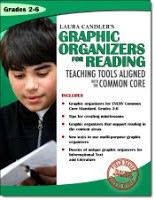Comparing and Contrasting Two Models
“How does Power Reading Workshop fit with the Daily 5?”
I’ve been asked that question several times recently, so I decided to tackle it on my blog. I feel fortunate to have been a part of a summer book study that examined The Daily 5, an outstanding resource for teachers written by “the sisters,” Gail Boushey and Joan Moser. After participating in that book study, I feel more confident about exploring the similarities and differences between Power Reading Workshop and The Daily 5. Both programs empower students to become better readers by allowing them to select and read books of their own choosing. In both programs, reading instruction takes place through mini-lessons, independent conferences, and small guided reading group lessons.
My response is a bit lengthy, but this question is important and it deserves an in-depth answer. As a part of my response, I’ll also dig into the two follow-up texts, the sisters’ CAFÉ Book and my own Graphic Organizers for Reading: Teaching Tools Aligned with the Common Core.
Discovering the The Daily 5
I first read The Daily 5 shortly after it came out in 2006, and I was impressed by the sisters’ inspirational writing style and by the program itself. Their book outlines the five components that make up their literacy program, describing a learning environment in which students are responsible for their own growth as readers. Their methods surpass the basic reading workshop approach described in many other books. However, I experienced two big stumbling blocks when it came to implementing the Daily 5 model. First, as a 5th grade teacher, I didn’t have two or three hours to devote to literacy instruction, and I wasn’t convinced that my students needed all five components. The other problem was that the examples in the book were from primary classrooms, and the strategy descriptions did not include enough detail for me to understand how to implement the program in an upper elementary classroom.
Step-by-Step with Power Reading Workshop
As much as I enjoyed the book, I didn’t feel comfortable implementing reading workshop that year. However, I did continue to search for more information on the topic. I was inspired by two more books, The Book Whisperer andIgniting a Passion for Reading, but what I really wanted was a set of step-by-step directions telling me how to get started.
 Eventually, I jumped in and started implementing the reading workshop model in my classroom. I tweaked some of the strategies I had been reading, and I developed some of my own, creating the program I now call Power Reading Workshop. Within just a few weeks, it became obvious that these methods were working extremely well and that my 5th graders were starting to love reading. After the first quarterly benchmark test, it was obvious that they were becoming better readers, too! It was at that point that I started writing down everything I was doing and compiling it to share with others. It took several years of working with the program and getting feedback from others teachers, but eventually I published Power Reading Workshop: A Step-by-Step Guide, the first reading workshop guide with easy, step-by-step directions.
Eventually, I jumped in and started implementing the reading workshop model in my classroom. I tweaked some of the strategies I had been reading, and I developed some of my own, creating the program I now call Power Reading Workshop. Within just a few weeks, it became obvious that these methods were working extremely well and that my 5th graders were starting to love reading. After the first quarterly benchmark test, it was obvious that they were becoming better readers, too! It was at that point that I started writing down everything I was doing and compiling it to share with others. It took several years of working with the program and getting feedback from others teachers, but eventually I published Power Reading Workshop: A Step-by-Step Guide, the first reading workshop guide with easy, step-by-step directions.
Comparing and Contrasting Approaches
Let’s look at the Power Reading Workshop (PRW) and The Daily 5 (D5) programs in more detail.
Exploring the CAFE Menu System
The CAFE Book is the follow up to The Daily 5. Apparently, the sisters received so many requests for more detailed information that they ended up writing The CAFE Book. It’s interesting to note that while they were writing this book, I was developing Power Reading Workshop to address the same need for step-by-step instructions! I just read The CAFE Book last month, and I LOVE it! To my amazement, this book has many of the missing pieces that I was looking for in The Daily 5. The CAFE Book outlines a literacy menu of reading strategies for Comprehension, Accuracy, Fluency, and Expanded Vocabulary. I was particularly impressed with the detailed information about how to conduct individual conferences and guided reading groups, as well as their huge appendix of specific information about how to teach reading strategies. I highly recommend this book as a supplement to Power Reading Workshop, because the CAFE menu approach can easily be integrated into the basic Power Reading Workshop model after the first 10 days of instruction.
Graphic Organizers Aligned with the Common Core
 The final piece of the puzzle can be found in Graphic Organizers for Reading: Teaching Tools Aligned with the Common Core. I’ve always loved using graphic organizers in my teaching, and when I began implementing reading workshop, I realized how easy it was to create mini lessons from graphic organizers. The book was first intended as supplement to Power Reading Workshop, but then I began learning about the new Common Core State Standards, and realized it could be much more. It occurred to me that all of the reading standards could be taught by using a graphic organizer to frame each lesson! I organized the chapters in the book to align with Common Core State Standards, so the mini-lessons provide an easy way to make sure you are meeting the standards for your grade level.
The final piece of the puzzle can be found in Graphic Organizers for Reading: Teaching Tools Aligned with the Common Core. I’ve always loved using graphic organizers in my teaching, and when I began implementing reading workshop, I realized how easy it was to create mini lessons from graphic organizers. The book was first intended as supplement to Power Reading Workshop, but then I began learning about the new Common Core State Standards, and realized it could be much more. It occurred to me that all of the reading standards could be taught by using a graphic organizer to frame each lesson! I organized the chapters in the book to align with Common Core State Standards, so the mini-lessons provide an easy way to make sure you are meeting the standards for your grade level.
Complementary Reading Workshop Models
The way I see it, Power Reading Workshop and The Daily 5 have many similarities. Both programs are designed to empower students with a love of reading and to provide them with the tools to become better readers. The components of each program can be integrated together and adapted to meet the needs of your class. I encourage you to learn more about both Power Reading Workshop and The Daily 5 because both programs include strategies that will enrich your reading instruction. I do not mean for my review of The Daily 5 and the Cafe Book to be critical because both books are amazing! However, I did not feel the Daily 5 met my needs as a 5th grade teacher and the Cafe Book had not yet been published when I wrote my two books.
Power Reading Workshop and Graphic Organizers for Reading are both available on Amazon.com, and if you click on those titles, you can read the reviews there. If you are interested in the digital copies of these books, you can get the digital versions for FREE when you order the print copies directly from my publisher. Just go to this page on Teaching Resources and follow the links.
To find more resources for reading workshop, visit the Reading Workshop page on Teaching Resources. You’ll find links to all of these books and other resources to guide you on your reading workshop journey!